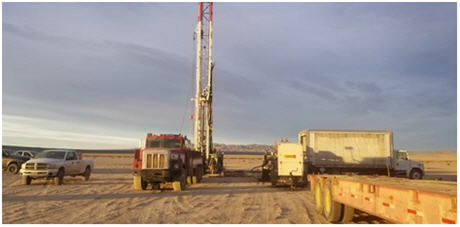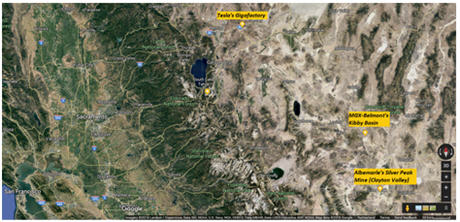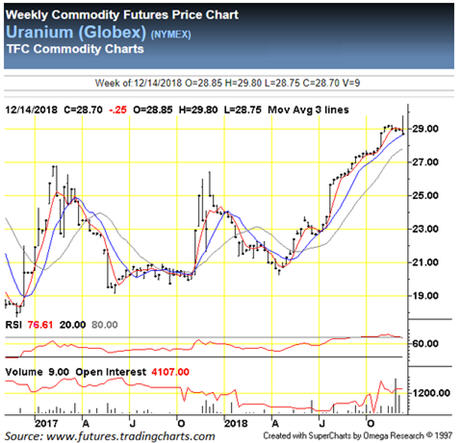Belmont Re-Starts Drilling at Kibby Basin Nevada Lithium Brine Project with MGX Minerals; Adds Two New Key Members to the Board of Directors
.jpg) Beautiful winter sunshine has finally cleared the snow over Kibby Basin, making current conditions feasible for drilling. (Photo courtesy of Belmont Resources Inc.)
Beautiful winter sunshine has finally cleared the snow over Kibby Basin, making current conditions feasible for drilling. (Photo courtesy of Belmont Resources Inc.)
Today, Belmont Resources Inc. announced that drilling at the Kibby Basin Project with MGX Minerals Inc. has re-commenced. The company also reported that Jared Lazerson, CEO of MGX Minerals (currently owning a 25% interest of the Kibby Basin Project) and financier Karim Rayani have joined Belmont’s Board of Directors.
“Previous drilling has shown consistent lithium in clay mineralization 1200-1700 feet [366-518 m] up to 580 ppm Li and moderate lithium mineralization at shallow depths to 300 feet [91 m] up to 100 ppm Li.” (See Qualified Person’s review of technical information)
This time at a different location in the basin, the current hole (KB-4) is planned to be drilled to a depth of 300 m, which has been previously estimated to take about a week.

Full size / MT section of KB-4 (as “A”) showing fault offset of MT conductor.
Geophysical and geological interpretation has indicated that potential geothermal activity may have brought concentrations of dissolved minerals (e.g. lithium) close to the surface.
Hole KB-4 is targeting a potential fault (as interpreted from the 2018 MT geophysical survey data), which looks to be located beneath the purple area of high conductivity (see figure to the right). KB-4 is planned to be drilled into the center of the 2016 measured gravity low targeting the center of the anomaly on the interpreted fault.
According to below generalized cross-section of the Clayton Valley (the valley also hosts Albemarle’s Silver Peak Project, North America’s only lithium brine operation located 65 km south of Kibby Basin): Faults appear to play a significant role in the accumulation and concentration of lithium brine at Clayton Valley, where the most productive pay zone, the Main Ash Aquifer (“major tuff-bed aquifer”), hosted brine with the highest grade (320 ppm lithium), whereas more distant parts of the same aquifer only hosted low grades of 40 ppm and less than 2 ppm lithium. It remains to be seen if the same holds true at Kibby Basin as, naturally, each play and geological setting is unique despite many similarities. Nevertheless, Belmont believes that this is the perfect spot to drill now.

Full size / Generalized cross-section of the Clayton Valley Playa, showing structural position of the major tuff-bed aquifer (“Main Ash Aquifer”) and inferred directions of aquifer movement (source: “Origin of the lithium-rich brine, Clayton Valley, Nevada”, 1986)

Full size / The thickness of the Main Ash Aquifer at Clayton Valley ranges between 3-9 m (10-30 feet) near faults.(after Zampirro, 2003).

Full size

Full size
Below figure (from the 2018 MT Geophysics Study) shows that KB-4 (as “A”) is located within the purple area of relatively high conductivity near surface (at elevation 500 m), whereas KB-3 (as “E”), KB-2 and KB-1 were drilled at the edge of this area. The depth to the top and bottom of the conductor is also indicated on that figure; e.g. at KB-4, the top is located at approximately 440 ft (134 m) depth and the bottom of the conductor is at a depth of 1,445 ft (440 m). Therefore, as KB-4 is being drilled to the proposed depth of around 300 m, it is targeted to drill right into this conductor with the goal of intersecting lithium brine, which is typically conductive.

Full size
A few days ago, the truck-mounted Ingersoll Rand RD 10 rig has been set up to drill hole KB-4. This is a bigger and more powerful rig than the one used to drill the previous hole KB-3, which obviously did not have the pulling force necessary to free the steel casing, for what reason the down-hole geophysics could not be applied as such a device does not work through steel. As the KB-3 hole then caved in, the drillers could not pump test the multiple aquifers encountered throughout the hole. By using a larger and stronger drill rig this time does, of course, not guarantee that this hole will be more successful or that no other kinds of unexpected difficulties could occur, but following the challenges with the last hole, it certainly makes sense to use a different rig now.

Full size / Recent photo showing preparations to drill hole KB-4 at Kibby Basin (below photos also sourced from Harris Exploration Drilling & Associates Inc.)

Full size

Full size

Full size
In October, Belmont announced an expanded drill program with plans of up to 1,463 m (4,800 ft.) of additional drilling across 4 shallow holes as already permitted within the Kibby Basin. Therefore, if KB-4 does not encounter any lithium brine, or drilling problems occur, Belmont may continue drilling elsewhere in the basin, for which additional financing would be required.

Full size
Today, Belmont announced the appointment of Jared Lazerson (CEO and Director of MGX Minerals Inc.; CSE: XMG) to its Board of Directors. MGX Minerals is partnered with Belmont on the Kibby Basin Property with a current 25% interest and the right to earn up to 50% interest with the goal of forming a 50/50 joint venture to utilize MGX Minerals’ rapid lithium extraction technology. MGX Minerals says to have developed some of the most advanced and low-cost technology in the world for lithium extraction from brine by eliminating the solar evaporation step, thus aiming to reduce processing time from up to 2 years down to as little as 1 day. Mr. Lazerson represents MGX Minerals’ interests on the Belmont Board. MGX Minerals currently owns 4 million shares of Belmont with 4 million two-year warrants exercisable at 8 cents in the first year and at 10 cents in the second year, and also has the right to acquire up to 10 million shares of Belmont at 20 cents for 3 years. Mr. Lazerson started MGX Minerals in 2014 and has overseen the growth of the company that now includes multiple industrial technology subsidiaries including rapid lithium extraction technology and battery mass storage, with current mineral exploration operations in four countries. MGX Minerals was the winner of the 2018 Standard & Poors Global Platts Metals Global Award for Leadership in Base and Specialty Metals. Mr. Lazerson holds a B.A. in International Relations from the University of Pennsylvania.
Belmont has also appointed financier Karim Rayani as a new Director. He has spent the last 14 years providing management consulting and investment banking services to companies in the junior mining, bio-medical and technology sectors, and assisted in raising >$45 million over the last 4 years for public and private companies. Formerly, he was head of Bloomberry Capital Group, a Vancouver-based merchant bank and capital advisory firm. Currently, he is Chairman of R7 Capital Ventures; President/CEO/Director of District 1 Exploration; and Director of Fiber Crowne Manufacturing. His business endeavors have enabled him to establish a global network of contacts with a focus on institutional accounts, and will assist Belmont in raising financing for its ongoing exploration projects.

Full size
In March 2018, Belmont received a Geophysical Report which includes the results of a Spartan Magnetotelluric (MT) Survey over the Kibby Basin. The survey was started in January by renowned Quantec Geoscience Ltd. and covered most of Belmont’s claims. One of the best identified zones of high conductivity / low resistivity is interpreted to be 6 km long and 3.5 km wide, including a thick (up to 1 km) zone of low resistivity (between 1 and 0.14 Ohm-meters). See Rockstone Report #11"Ohm-m! The Divine Sounding of Resistivity" for further details on resistivity and comparisons with other lithium brine projects.
See also previous Rockstone Report #17 with comparisons to the near-by Clayton Valley, home of North America’s only lithium brine operation.

Full size / Belmont’s Kibby Basin is located just 65 km from the Clayton Valley, where large evaporation ponds represent North America’s only lithium brine operation, whereas MGX Minerals Inc. intends to deploy its rapid lithium extraction technology at Kibby in case favorable lithium brine zones are encountered with drilling. (See map online here)

Full size / Map showing the location of MGX-Belmont’s Kibby Basin, Tesla’s Gigafactory and Albemarle’s Silver Peak Lithium Mine. (See map online here)
Bottom Line
The importance of a potential lithium brine discovery by Belmont in Nevada, combined with MGX’s rapid lithium extraction technology, cannot be understated. The US may support new domestic lithium production as the battery metal is on the list of strategic commodities deemed critical to economic and national security. MGX’s new way to extract lithium without solar evaporation may come at a perfect time as the US currently produces only about 4% of global lithium supply, all of it coming from Albemarle’s evaporation ponds at the Silver Peak Mine located 65 km south of Kibby Basin. While companies have been fighting over water rights in the “overappropriated” Clayton Valley, Belmont has already filed for water rights at Kibby Basin. Another advantage is that Belmont-MGX control almost the entire Kibby Basin, making an entry for other companies difficult in case drilling indeed finds exploitable lithium.

Full size
Uranium at Athabasca Basin
Having put its uranium projects on the back burner during slow times in the uranium market, Belmont may be looking to restart these exploration plays located in the heart of the most prolific uranium mining region of the world.
With uranium prices on the rise again since April/May 2018, Belmont’s Crackingstone and Orbit Properties near Uranium City within the Athabasca Basin in Saskatchewan may see renewed interest and work efforts by Belmont in its 50/50 joint venture with International Montoro Resources Inc. (TSX.V: IMT) having previously spent around $2 million on the projects only to see uranium prices fall off.

Full size / Source

Full size / Source
Fission 3.0 Corp. owns 5 prospective uranium properties in the Beaverlodge area “with potential to host near surface, high-grade uranium”, the company states on its website. “Of these, recent and historical work at three projects has already confirmed the presence of uranium.”
Belmont-IMT’s properties are neighboring some of the Fission 3.0 projects. Fission 3.0 also says: “The Beaverlodge area is a former uranium producing district, that was home to 52 mines and 12 open-pit mines through the 1950’s and 1960’s. Thanks to Fission 3.0’s airborne survey techniques and careful research, several prospective, under-explored areas have been identified.”
Crackingstone
According to the historic Technical Report on the Crackingstone River-Ruza Property (July 11, 2006):
“Northern Saskatchewan has the richest and largest reserves of uranium in the world. It is important to remember that the Beaverlodge area along the north shore of Lake Athabasca was and still is an important metallogenic province of uranium... The Crackingstone River-Ruza property (CRR) is located 8 km southwest from Uranium City, in the Northern Mining district of Saskatchewan. The property is favorably located... A major fault, the Black Bay Fault, is located near the southeast corner of the property. The Black Bay Fault forms the common boundary between the Zemlak and Beaverlodge Domain...
The bulk of uranium production in the Beaverlodge area came from the Fay-Ace, VernaBolger, Hab, Rix Smitty, Cinch Lake, Cayzor, Dubyna Lake, Gunnar and other small deposits for a total production of 70,250,000 lbs U3O8 averaging 0.24% U3O8. The grades ranged from 0.18% to 0.43%... Most of the uranium deposits and occurrences are contained within brittle and brittle-ductile fractured and sheared rocks... Recent price increases for uranium has generated considerable interest on both areas and has generated considerable staking and re-staking in these areas.”
Historic Exploration
February 2007: Belmont and IMT completed a 87 km line-cutting program consisting of establishing grid lines and a Mag/VLF-EM ground geophysical survey over 750 hectares.
August-October 2007: Channel (278) and grab (12) sampling program with samples assaying over 0.59% U308, and a radon gas survey. Radon gas survey covered approx. 4.65 km at 50 m sample intervals (93 samples) around the intersection point of the Crackingstone and Boom Lake faults.
October 2007: MPX Geophysics Ltd. conducted 1,391 km of helicopter airborne magnetic and radiometric survey (100 m flight line spacing over the Crackingstone and Orbit claims).
July 2008: Completion of a 20 hole diamond drill program totaling 3,075 m, which confirmed the presence of uranium mineralization for a strike distance of 1,800 m. Eight of the holes tested a 600 m strike length long conductor starting from the Beck 94 showing. Assays graded up to 0.37% U308, including intersections of 0.3 m assaying 2.087% U308 including a 3 m intersection assaying 0.36% U308; 10.6 m intersection including 0.4 m of 0.182% and many others (see all historic drill results here).
Historic Exploration at Orbit
April 2008: Completion of an Aeroquest Airborne magnetic/electromagnetic survey, which consisted of 1,319 line km’s using the Aerotem IV system. This confirmed 19 electromagnetic conductors of which 6 have significant strike length from 1 km to 3.5 km. Four of the conductors are coincident with significant radioactive zones detected in the 2007 airborne survey (see October 2007 above) and historical uranium showings.
September 2011: Completion of a sampling program on 3 NE linear radiometric (U) anomalies which transected the property from the southwest corner at Orbit Bay to the northeast corner of the claim group at Orbit Lake. Results included numerous rare earth elements. Further results can be reviewed in the December 5, 2011 news-release.
Cautionary Note: The historical information is relevant only as an indication that some mineralization occurs on the properties, and no resources, reserve or estimate is inferred. A qualified person has not done sufficient work to classify the historical information as current mineral resources or mineral reserves; and neither Rockstone, Belmont-IMT nor Zimtu Capital is treating the historical information as current mineral resources or mineral reserves.



Technical Perspective
 Link to updated chart (15 min. delayed): https://schrts.co/o1BKLg
Link to updated chart (15 min. delayed): https://schrts.co/o1BKLg
Company Details

Belmont Resources Inc.
Suite 600 - 625 Howe Street
Vancouver, BC, V6C2T6 Canada
Phone: +1 604 683 6648
Email: gmusil@belmontresources.com
www.belmontresources.com
Shares Issued & Outstanding: 88,226,620

Chart
Canadian Symbol (TSX.V): BEA
Current Price: $0.045 CAD (12/17/2018)
Market Capitalization: $4 Million CAD

Chart
German Symbol / WKN (Frankfurt): L3L1 / A1JNZE
Current Price: €0.02 EUR (12/17/2018)
Market Capitalization: €2 Million EUR
Previous Coverage
Report #19 “Belmont to Start Drilling for Lithium Brine at Kibby Basin in Nevada after Thanksgiving"
Report #18 “Belmont reports final lithium assays from first hole of 2018 and gets ready for continued drilling at Kibby Basin in Nevada"
Report #17 “MGX-Belmont Announce Next Round of Encouraging Lithium Drill Results from Nevada"
Report #16 “MGX-Belmont sample up to 580 ppm lithium in sediments at Kibby Basin Nevada Joint Venture"
Report #15 “MGX-Belmont Drilling Finds Multiple Brine Prospective Zones at Kibby Basin Lithium Joint Venture in Nevada"
Report #14 “The Drills are Turning at MGX-Belmont‘s Kibby Basin Lithium Joint Venture in Nevada”
Report #13 “MGX and Belmont to Start Drilling at Kibby Basin Lithium Project in Nevada on Saturday”
Report #12 “MGX and Belmont Form Nevada Lithium Joint Venture at Kibby Basin”
Report #11 “Ohm-m! The Divine Sounding of Resistivity”
Report #10 “Belmont Resources (BEA.V): Cheapest US lithium play may just be what others promised”
Report #9 “It‘s Time For Belmont To Shine In Nevada”
Report #8 “Bingo! Belmont finds striking drill targets for lithium brine deposits at Kibby Basin in Nevada”
Report #7 “The Missing Puzzle Piece to Discover Lithium Aquifers in the Kibby Basin of Nevada?”
Report #6 “Belmont on track to eclipse the Clayton Valley”
Report #5 “Belmont getting ready to drill for untapped lithium brines at Kibby Basin in Nevada”
Report #4 “The perfect lithium basin?”
Report #3 “Prominent gravity low identified on Kibby Basin Lithium Brine Property in Nevada”
Report #2 “Dark clouds over Clayton Valley and green lights for Belmonts Kibby Basin Project”
Report #1 “Early Report on Belmont Resources”
Contact:
Stephan Bogner (Dipl. Kfm., FH)
Rockstone Research
8260 Stein am Rhein, Switzerland
+41-44-5862323
info@rockstone-research.com
www.rockstone-research.com
Disclaimer: This report contains forward-looking information or forward-looking statements (collectively "forward-looking information") within the meaning of applicable securities laws. Forward-looking information is typically identified by words such as: "believe", "expect", "anticipate", "intend", "estimate", "potentially" and similar expressions, or are those, which, by their nature, refer to future events. Rockstone Research, Belmont Resources Inc., MGX Minerals Inc. and Zimtu Capital Corp. caution investors that any forward-looking information provided herein is not a guarantee of future results or performance, and that actual results may differ materially from those in forward-looking information as a result of various factors. The reader is referred to the Belmont´s and MGX Minerals´ public filings for a more complete discussion of such risk factors and their potential effects which may be accessed through the Belmont´s and MGX´s profile on SEDAR at www.sedar.com. Please read the full disclaimer within the full research report as a PDF (here) as fundamental risks and conflicts of interest exist. The author, Stephan Bogner, holds a long position in Belmont Resources Inc. and MGX Minerals Inc., and is being paid by Zimtu Capital Corp. for the preparation, publication and additional distribution of this report, whereas Zimtu Capital Corp. also holds a long position in Belmont Resources Inc. and MGX Minerals Inc. Belmont and/or MGX pay Zimtu for the preparation, publication and additional distribution of this report. Any mentioned historical information is relevant only as an indication that some mineralization occurs on the properties, and no resources, reserve or estimate is inferred. A qualified person has not done sufficient work to classify the historical information as current mineral resources or mineral reserves; and neither Rockstone, Belmont-IMT nor Zimtu Capital is treating the historical information as current mineral resources or mineral reserves. For any mentioned technical information see Belmont´s Qualified Person’s review of such in the respective news-releases.